#passive CWDM Mux
Explore tagged Tumblr posts
Text
Optimize Network Performance with CWDM Mux/Demux
CWDM Mux/Demux enables efficient wavelength multiplexing and demultiplexing, expanding fiber capacity and optimizing data transmission. Perfect for telecommunications and data centers, it ensures seamless scalability and cost-effective network solutions. Contact DK Photonics who is a leadig company of these products.
To know more:
0 notes
Text
Why Not Build a 10G CWDM Network for Higher Capacity?
Although the 40G and 100G technologies develop vigorously recent years to meet the increasing need of higher capacity, they are still not widely accepted and applied due to high deploying cost. Under this case, choosing to build a 10G network is always the first choice for most users. But except upgrading our system, what else can we do when the 10G network can’t offer enough capacity? To address this issue, telcom engineers and researchers suggest that we can deploy the 10G CWDM networks. With use of CWDM optical multiplexer, this solution offers a highly cost effective method to gain more capacity on the basis of 10G network. Let’s study the benefits of 10G CWDM network and its two basic common network infrastructures in details.
What Can We Benefit from 10G CWDM Network?
In contrast to 10G DWDM network, 10G CWDM network can neither offer so high data capacity nor transmit the signals so long. But on the other hand, 10G CWDM network is an easier-to-deploy and less expensive solution that can well serve for a wide range of optical applications. Let’s study the main benefits of 10G CWDM networks.
It is possible to add connections for transmitting more data in 10G network, which makes the whole network load increasing from 10G to 40G or 100G possible.
CWDM Mux Demux is the key component of 10G CWDM network. As a passive component, it doesn’t require extra power, which is an ideal option for deploying 10G CWDM network.
Instead of upgrading system, deploying 10G CWDM network to get more capacity can saves a lot of money due to the economical 10G hardware and cheap passive CWDM Mux Demux.
Understanding Common 10G CWDM Network Infrastructures
10G CWDM system is a passive optical network, which supports 10G transmission with any protocol over the optical link, as long as the 10G signals are at the specific CWDM wavelengths. At present, there are two common CWDM network infrastructures. One is 10G CWDM point-to-point network, and the other is 10G CWDM ring network. The following will introduce the two common infrastructures in details.
10G CWDM Point-to-Point Network: it is the simplest network infrastructure of the CWDM networks. As shown in the following figure, there are two passive CWDM Mux Demux deployed in the 10G network that offers 8 channels to multiplex the signals from 8 different optical fiber link into an integrated signal. Thereby, the signal can be transmit through only one fiber, which means there are 7 virtual fiber created with higher capacity for transmitting more data. As for the cheap passive CWDM Mux Demux, it can be available at very good price that costs less than upgrading the system from 10G to 40G or 100G. Undoubtedly, deploying a 10G CWDM point-to-point network is very economical solution for higher capacity.

10G CWDM Ring Network: it is deployed on the basis of 10G CWDM point-to-point network. Compared to point-to-point network, the ring network is much more complex that needs other optical CWDM components like CWDM OADM. By adding CWDM OADM, two or more point-to-point network can be connected together, which can finally achieve a 10G CWDM ring network. To better understand how does the 10G CWDM ring network work, here offer a figure that shows four buildings are connected by several 8 channels CWDM Mux Demux and CWDM OADM for your reference.

Conclusion
Unlike upgrading the network from 10G to 40G or 100G, building a 10G CWDM network doesn’t requires changing all the network equipment which may cost highly. It only need CWDM transceiver and CWDM Mux Demux to be deployed in the original 10G network. For a complex 10G CWDM network, additional optical equipment like CWDM OADM are required. If you come across the capacity-hungry issue, building a 10G CWDM network would be a nice option for higher capacity.
0 notes
Text
Company Profile
https://www.optical-sintai.com/company-profile.html

Guangzhou Sintai Communication Co., Ltd, which was founded in early 2013, is specialized in the optical transmission field with R&D, production, sales and customer service. And shortly after that our OTNS8600 optical transmission network system was brought to the market. Especially, we were the one of the first companies to provide 100G wavelength division products with professional solutions in the industry in 2015. We’ve been dedicated to providing optical transmission network systems and optical transmission optimization solutions and have become one of the top optical communication products manufacturers and service providers in China.
We are committed to providing integrated optical transport network systems and optical transport optimization solutions, and our products mainly contain the WDM/ OTN systems (10G/ 25G/ 40G/ 100G/ 200G WDM system, 5G fronthaul transmission WDM systems), optical amplifier system (OEO/ EDFA/ SOA), optical protection system (OLP/ OBP/ FMS), passive optical device (AWG/ CWDM/ DWDM MUX&DEMUX/ DCM/ Splitter) and optical transceivers (SFP/ SFP+/ SFP28/ QSFP+/ QSFP28/ CFP/ CFP2). They are widely used by telecom operators and private network industry customers, including ISP, electric power, IDC, education, transport, radio and television, network security, big data and cloud services, etc.
Our products have its patented technology through our independent R&D and won the authorized certification, such as the design patent certificate, software copyright register certificates and series of quality management and test certificates.
After years of development, our products and services have extended to various industries at home and abroad. Our company base is at Guangzhou with branches at North, Northwest and East China. And the establishment of brand advantage has promoted the construction of our international marketing network. The awareness of Sintai is continuously increasing in the key markets. Our overseas business has extended to Europe, Middle East, Southeast Asia, North America, South America, Africa and so on.
In order to support our increasing domestic and overseas markets, we have built professional production team, sales team, service team and R&D team to provide the industry-leading and comprehensive products. With many years’ experience of optical communication technology, we are focusing on optical transmission and optical device technology to continuously provide a forward-looking technology development strategy and products with core market competitiveness. And we are dedicated to provide every customer the perfect pre-sales, sales and after-sales service. Customers’ concerns will be always taken good care of by our professional service teams.
Over the years, Sintai has been centering on offering customer oriented service, high quality products and optimized optical transport solutions in the optical transmission field. Creating value for customers, achieving common development with customers and making contributions to the society will always be the fundamental and mission of the company's long-term work.
0 notes
Text
CWDM: What You Need to Know
Wavelength division multiplexing (WDM) is a technology for transporting large amounts of data between sites. It increases bandwidth by allowing different data streams to be sent simultaneously over a single optical fiber network. There are two main types of WDM systems: coarse wavelength division multiplexing (CWDM) and dense wavelength division multiplexing (DWDM). This article provides some knowledge about CWDM.
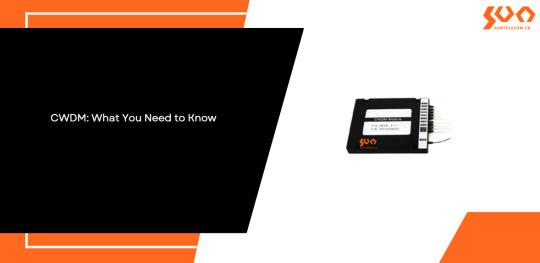
What is CWDM?
Coarse Wavelength Division Multiplexing (CWDM) is a wavelength multiplexing technology for cities and access networks. The word coarse means the wavelength spacing between channels is relatively large. Furthermore, CWDM is an ideal solution for short-range applications and is used to improve the transmission capacity of optical fiber and the utilization of optical fiber resources.

CWDM Operating Principle
CWDM was standardized by the ITU-T G.694.2 based on a grid or wavelength separation of 20 nm in the range of 1270-1610 nm. It can carry up to 18 CWDM wavelengths over one pair of fibers. Each signal is assigned to a different wavelength of light. Each wavelength does not affect another wavelength, so the signals do not interfere. Each channel is usually transparent to the speed and data, so the voice, video, and other services can be transported simultaneously over a single fiber or fiber pair.
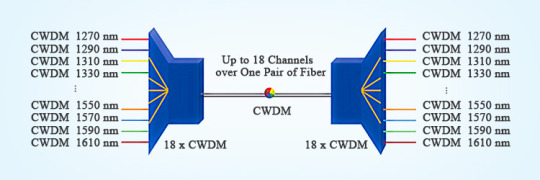
CWDM Network Component
A multiplexer (Mux) combines multiple wavelength channels on a single fiber, and a demultiplexer (Demux) separates them again at the other end. A Mux/Demux set-up is used to increase the end-to-end capacity of a deployed fiber. The Mux is located in the central office, and the Demux is located in the cabinet or splice closure from which the fibers go to their destination in a star-shaped topology.

Features and Benefits
CWDM provides low insertion loss, low polarization-dependent loss, low cost, low-temperature sensitivity, low power consumption, high channel isolation, high data rate, high stability, high reliability, small size, and ease of installation and deployment.
Applications
CWDM is used in metropolitan area networks (MAN), local area networks (LAN), storage area networks (SAN),10-gigabit ethernet, passive optical networks (PON), WDM transmission systems, FTTx networks, 5G front-haul, data centers, online monitoring, fiber optic amplifier, etc.

Conclusion
CWDM has become the preferred solution for increasing the bandwidth of metro/regional and optical access networks. And it has proven to be sufficiently robust, low-cost, and reliable for upgrading the optical network to accommodate future growth. Sun Telecom specializes in providing one-stop total fiber optic solutions for all fiber optic application industries worldwide. Contact us if any needs.
1 note
·
View note
Text
Netro Networks Pvt Ltd
Dear Entrepreneurs,Greetings from Netro Networks, Hope you all are doing good. Here I would like to introduce my company Netro Networks Pvt Ltd. Netro Networks is a Cisco partner Company. Netro Networks carries and distributes only the best networking products from top-tier manufacturers throughout the world. Netro Networks have end to end Networking Products and solutions for LAN, WAN, Fiber and wireless network. We Deal in the Following Products. 1. Cisco - We have web Switches, Routers, Asa ((Firewall), IP Phones & IP Cameras. 2. SyRotech - We have GPON/EPON OLT, 100% compatible Optical Transceivers, Media converter, Fiber Switch, POE Switch, RPOE Switch, FWDM/CWDM/DWDM-Mux/DeMux, FTTH Passive Product-PLC Splitter, FDB, FTTH wall Outlet, Drop Cable, Fast Connector, FMS/LIU, Splicing Machine, OTDR and Power Meter. 3. BARCO - We have various products of Weshare family and powerful ClickShare wireless presentation system. 4. Ubiquiti -We have P2P and P2M Wireless Radio and AP and Antenna and passive POE Switches. 5. Mikrotik -We have P2P, P2M Wireless Radio, Router, Switch and Antenna. Our customer base includes major SI, Enterprise Customers, Data Centers, Networking- Resellers and Service Providers. We look forward to a successful working relationship in the future. Thanks and Regards, Sales Team 9971188176Note:- We will keep you sending latest updates and offers on your email so please save this Email address in your Contacts.Search Netro Networks on Google+, Facebook, Twitter, LinkedIn, Pinterest and Google Business.
1 note
·
View note
Link
Dual-fiber CWDM Mux Demux is a passive device used to multiplex and demultiplex wavelengths to expand network capacity. This component must work in pairs to transmit bi-fiber in both directions. It supports up to 18 channels for sending and receiving 18 signals with wavelengths from 1270 nm to 1610 nm.
Details of 16 Channel Dual Fiber CWDM Mux Demux Fiber Optic Transmission Equipment
Features
Low Insertion Loss
High Channel Isolation
Optical path epoxy free
Excellent thermal stability and reliability
Good channel-to-channel uniformity
Wide Operating Wavelength: 1270nm-1610nm /(1261nm~1611nm)
Wide Operating Temperature: -20 to +70℃
Telcordia GR-1221 Compliance and RoHS Environmental Protection Standard
Application
CWDM Network
Add/Drop System
CATV Fiberoptic System
Metro/Access Network
Fiber Optical Amplifier.

0 notes
Text
Uses for an optical isolator

Rotators Difference between an Optical Circulator & Isolator & RotatorĪn optical circulator is used to route the incoming light signals from port 1 to port 2 in a way that if some of the emitted light is reflected back to the circulator, it doesn’t exit from port 1 but from port 3. This rotator is used for amplitude modulation of light and is an integral part of optical isolators and optical circulators. What is an optical rotator?Īn optical rotator is typically an in-line Faraday rotator that is designed to rotate the polarization of the input light by 45 degrees. This is what makes it possible to achieve higher isolation. Hence, it adds to the total of 90 degrees when light travels in the forward direction and then the same in the backward direction. It happens because of the change in the relative magnetic field direction, positive one way, and negative the other way. It means that the rotation is positive 45 degrees in the forward direction and negative 45 degrees in the reverse direction. The polarization rotation caused by the Faraday rotator always remains in the same relative direction. Its main component is the Faraday rotator which ensures non-reciprocal rotation while maintaining linear polarization. What is an optical isolator?Īlso known as an optical diode, an optical isolator is an optical passive component that allows the light to travel in only one direction. While some circulators are three-port devices, there are also four-port circulators. In short, it is designed such that the light coming from one port exits from the next port. What is an optical circulator?Īn optical circulator is a high-performance light-wave component that is designed to route the incoming light signals from Port 1 to Port 2 and the incoming light signals from Port 2 to Port 3. Circulator & Isolator & RotatorĪs we are discussing specifically optical passive components, you will learn here about optical circulators, optical isolators, and optical rotators rather than their electronic counterparts. So, if you are curious to know about these little yet important optical passive components, read the blog till the end. We will first talk about what these components exactly are and then share what makes them different from each other. Today, we will discuss three different optical passive components, namely circulator & isolator & rotator. What is a polarization maintaining filter coupler?.A Concise Selection Guide for In-Line Polarizers.What is the importance of 80um PM fiber components?.The Growing Demand for PM Fiber Components in 2023 and Beyond.Why Should Polarization Maintaining Filter Coupler Feature High Extinction Ratio?.Polarizing Beam combiners/splitters (2).High Power Faraday Rotator and Isolator (1).(6+1)X1 Pump and Signal Combiner 2+1X1 Pump Combiner 8CH CWDM Module 16CH CWDM Module 19" rack mount chassis CWDM 1060nm Cladding Power Stripper 1064nm Band-pass Filter 1064nm Components 1064nm Fiber Collimator 1064nm High Power Isolator ABS plastic box Cladding Power Stripper Collimator Compact CWDM Module CWDM CWDM Multiplexer CWDM Mux/Demux CWDM MUX/DEMUX Module DWDM DWDM Multiplexer fiber optica connector fiber optic coupler FTTX Fused Coupler fused wdm FWDM High Power Fused Coupler High power isolator Isolator LGX CWDM Module Mini Size CWDM Mini Size Fused WDM Multimode High Power Isolator OADM optical circulator optical coupler Optical fiber communication optical isolator PLC Splitter pm circulator PM Components pm isolator pump combiner Pump Laser Protector WDM DK Categories

0 notes
Text
arkoptics.com
A passive multiplexer in most networks consists of a mux and demux optical component. The mux combines, or multiplexes, wavelengths onto a fiber. The demux on the other end of the connection splits, or de-multiplexes, the connections.
In DWDM system, DWDM mux demux is two indispensable modules. Mux (Multiplexer) is a module at the transmitter end that brings several data signals together for transporting over a single fiber, while Demux (Demultiplexer) is a module at the receiver end that separates the signals that come together and passes each channel to an optical receiver.
CWDM mux demux (Coarse Wavelength Division Multiplexer/Demultiplexer) is a flexible, low-cost solution that enables the expansion of existing fiber capacity. CWDM multiplexer is for combining signals together, while demultiplexer is for splitting signals apart.
A polarization-maintaining (PM) WDM filter is a small device used to multiplex PM signals while maintaining the output polarization. When you are using highly efficient systems, PM fibers and PM signals play a very critical role in ensuring the desired efficiency.
Fiber Patch Cord & Cable Assembly, often called fiber patch cable, fiber jumper, or fiber patch lead, is a length of fiber cable that terminated with fiber optic connectors (LC, SC, MTRJ, ST and etc.) at each end. The connectors allow fiber optic patch cord to be rapidly connected to an optical switch or other telecommunications/computer device.
Fiber loopback is widely used for various applications. In terms of telecommunication, loopback is a hardware or software method to feed a received signal or data back to the sender. It is very useful for solving physical connection problems.
Fiber terminators(Plug-in type or Build-out type) are used to terminate unused fiber connector ports in fiber optic systems so optical terminators unwanted reflections are not introduced back into the system. It is used in the fiber-optic networks to install on possibly unused ports.
Fiber optic isolator is a passive component used for fiber optic communications. As a magneto-optic device, the purpose of optical isolator is to allow light to be transmitted in only one direction. An optical isolator is a device that is designed to allow the optical signal travel in the forward direction while block reflections that would travel in the backward direction. Optical isolators are critically important in many applications in optical systems.
FBT splitter(fused biconical taper) is the traditional technology in which two fibers are placed closely together, typically twisted around each other and fused together by applying heat while the assembly is being elongated and tapered. A signal source controls the desired coupling ratio. The fused fibers are protected by a glass substrate and then protected by a stainless steel tube, typically 3 mm diameter by 54 mm long. FBT splitters are widely accepted and used in passive optical networks.
The PLC splitters are used to separate or combine optical signals. A PLC (planar lightwave circuit) is a micro-optical component based on planar lightwave circuit technology and provides a low-cost light distribution solution with small form factor and high reliability. PLCs are manufactured using silica glass waveguide circuits that are aligned with a v-groove fiber array chip that uses ribbon fiber. Once everything is aligned and bonded, it is then packaged inside a miniature housing. PLC splitters have high quality performance, such as low insertion loss, low PDL, high return loss, etc.
1 note
·
View note
Text
Optilink Networks Gpon Products, Gpon Olt, Gpon Switch, Gepon Products.
Optilink Networks Gpon Products, Gpon Olt, Gpon Switch, Gepon Products. Optilink Networks offers products such as metro ethernet switch, MEN Switch, MEN Switches, gepon onu, gepon, gepon olt, gpon, gpon olt, onu, olt, patch cords, men switch, plc splitters, sfp transceivers, xont etc.
Kindly select respective categories are Metro Ethernet Network Switches, Optilink MEN Series, DCN MEN Series, Web Smart, Fiber Data Series, Media Converters, Subscriber End Equipment XONT, Chasis Type OLT, Pizza Type OLT, SFP,155M, 1.25G Series, Copper Series, 10G Series, CWDM, Mux OR DeMux, OADM, CWDM SFP, Passives.
For more https://optilinknetwork.com/GPON
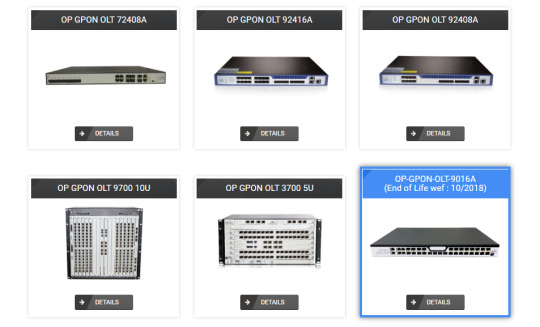
#Gpon Products#Gpon#GPON OLT#Gpon Switch#gpon olt price#Gepon Network#gpon olt price in india#gpon modem#gpon ont#gpon india
0 notes
Text
WDMs
https://www.china-tscom.com/products/wdm/

T&S has a profound optical process foundation on passive WDM devices; it has unique process technology in optical coating, optical element polishing, optical coupling and optical parameter testing, and is equipped with advanced automatic optical coupling and testing platforms. Provide highly reliable WDM series of products.
TFF Type WDM
T&S TFF WDM is based on Thin Film Filter (TFF) technology. Our Filter-Based WDM product family covers following wavelength windows commonly used in optical fiber systems: 1310/1490/1550nm (for FWDM Device), 1271~1611nm (for CWDM Device or Module), 1525~1565nm (C_band for 100G/200G DWDM Device or Module) and 1269.23~1318.35nm (for 800G LWDM Device or Module), 1271±3.5~1371±3.5nm (for MWDM Device or Module) and 1270/1310/1490/1534/1577/1610/1650nm (for Cex-wdm Modules, including GPON, XG-PON, NG-PON2 and OTDR )
PLC Type WDM
Instead of taking a thin film filter to mux or demux wavelengths, PLC type achieves the same goal by using chip PLC, which uniformly divides and guides light with different wavelengths. At T&S, we currently provide multi-channel AWG DWDM Modules and 4ch CWDM/LWDM Devices.
1525~1565nm (C_band for 100G multi-channel AWG Module) and 1271~1331nm&1295.56~1309.14nm(for PLC CWDM4&LWDM4 Devices, it used for 4x10 Gbps CWDM TOSA&ROSA for QSFP+ or 4X25 Gbps LAN-WDM TOSA&ROSA for QSFP+
0 notes
Text
Single Fiber CWDM MUX and DEMUX Tutorial
Understand Single Fiber CWDM MUX and DEMUX
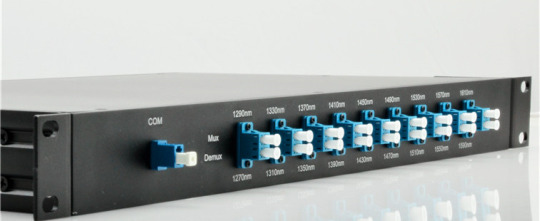
The CWDM technic multiplexes optical signals together on one single fiber. As a universal equipment, it can combine different wavelengths in a CWDM Mux/Demux to achieve this. Coupled with highly reliable passive optics certified for environmentally hardened applications, the CWDM Mux/Demux make operators take full advantage of available fiber bandwidth in local loop and enterprise architectures. CWDM Mux/Demux is a flexible and cost-efficient solution that expand the existing fiber capacity. When there is only one fiber available for network capacity expansion. Then, single fiber CWDM MUX and DEMUX is being used. The single fiber CWDM MUX DEMUX has a simplex line port (shown in the above picture), which is the biggest difference from the bidirectional CWDM MUX DEMUX on the appearance.
Working principle
The single fiber CWDM MUX/DEMUX uses the CWDM wavelengths in a way different from the bidirectional CWDM MUX DEMUX, so it can achieve dual way transmission. Each wavelength in bidirectional CWDM network runs on two opposite directions but just on one direction in single fiber CWDM network. There are two options for you if you want to build a dual way transmission link between two sites. First option is use one wavelength over duplex fiber with dual-fiber CWDM MUX DEMUX, the second option is use two wavelengths (one for TX and the other for RX) over simplex fiber with single fiber CWDM MUX DEMUX.

The picture shown above give us a description of the Use of CWDM Wavelength in Single Fiber CWDM Network. In this network, 16 wavelengths are used to support 8 pairs of dual-way transmission. On site A, there deployed an 8-channel single fiber CWDM MUX DEMUX using 8 wavelengths for transmitting and the other 8 wavelengths for received. On the opposite site B, also a single fiber CWDM MUX and DEMUX is deployed. However, the wavelengths for TX and RX are reversed. For instance, a pair of dual-way signal uses 1270nm for TX and 1290nm for RX on site A, while use 1290nm for TX and 1270nm for RX on site B. This is how the single-fiber CWDM MUX and DEMUX achieving dual-way transmission.
The Ports On CWDM MUX DEMUX
The basic function of the CWDM is to increase the network capacity by combine the data rate of variety wavelengths over the same fiber cable. So the must-have ports for these devices are channel ports supporting different wavelengths or Line port used to connect the WDM MUX/DEMUX.
Channel Port
There are 18 type of wavelengths of CWDM in total, from 1270nm to 1610nm with a channel space of 20nm. The following picture shows a CWDM MUX DEMUX with all the 8 CWDM wavelengths: 1470nm, 1490nm, 1510nm, 1530nm, 1550nm, 1570nm, 1590nm, 1610nm.
Line Port
There are two types of line port available for CWDM MUX DEMUX. One is dual fiber line port, and the other is single fiber line port. The selection of the line port depends on applications. If it’s a single-fiber WDM MUX DEMUX, there are only one direction for all the wavelengths to flow in. And the TX port and RX port of every duplex channel port supporting two different wavelengths.
Monitor Port
This port added wto bring more profits to the existing WDM network. A numner of technicians will add a monitor port on CWDM MUX DEMUX for better network monitoring and management. If you choose a single-fiber WDM MUX/DEMUX, the monitor port should be a simplex fiber optic port.
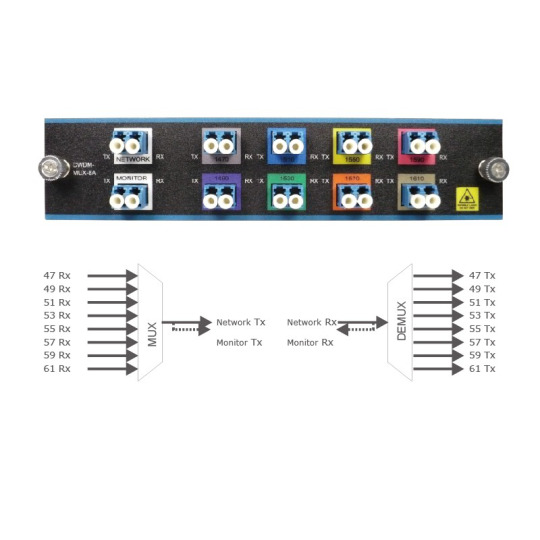
How to Install Your CWDM MUX DEMUX System?
In short, there are four major steps for a CWDM MUX DEMUX system installaltion:
1. Install the Rack-Mount Chassis
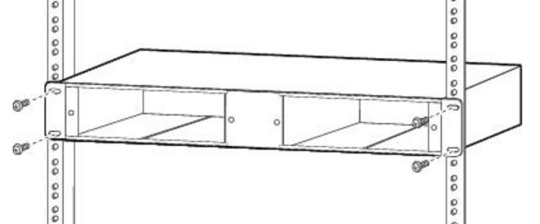
2. Install the CWDM MUX DEMUX Modules
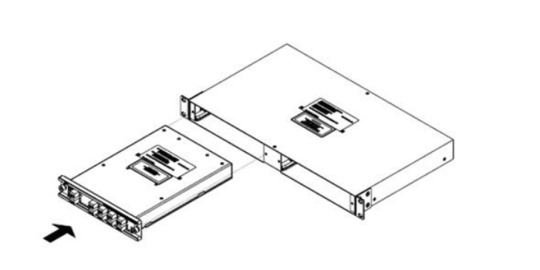
3. Connect the CWDM MUX DEMUX to Switch
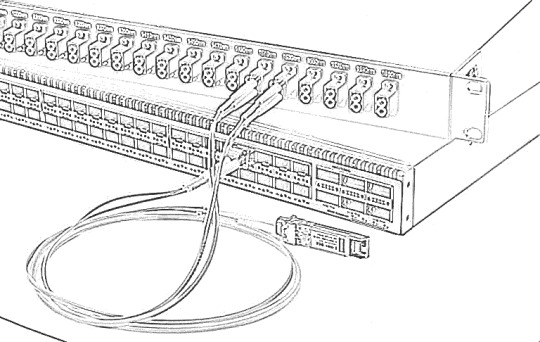
4. Connect the CWDM MUX DEMUX Pairs
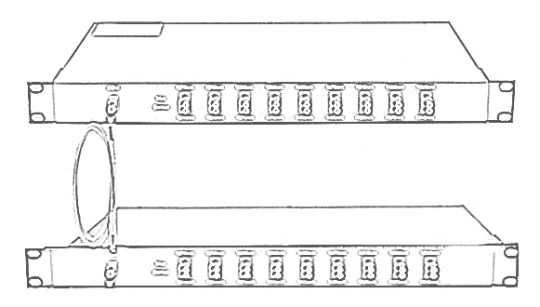
How to Select Fiber Optic Transceiver for Single Fiber CWDM MUX and DEMUX
Because of there has two different wavelengths on a duplex channel port, it could be confused when we need to select a CWDM transceivers for the single fiber CWDM network. So how to select it for single fiber CWDM MUX DEMUX? The Key elements is the wavelength for TX. Still take the above example, on site A 1270nm is used for TX, thus, a 1270nm CWDM transceiver should be used. On site B, a 1290nm CWDM transceiver should be used. The fiber optic transceivers used for single fiber CWDM MUX and DEMUX are different on the two sites.
10Gtek Single Fiber CWDM MUX DEMUX Solution
The products for CWDM network mentioned above are available in 10Gtek. 8 Channels Dual LC CWDM MUX/DEMUX are available and the special ports like pass port can be customized. Any interest, please feel free to contact [email protected] for more information.
The following shows 10Gtek Single Fiber 8 Channels Dual LC CWDM MUX/DEMUX channel port details.
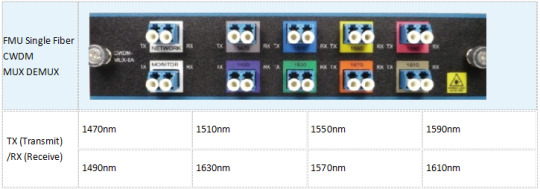
0 notes
Text
5G Fronthaul Semi-Active WDM System
https://www.optical-sintai.com/products/5g-fronthaul-semi-active-wdm-system.html
The 5G fronthaul transmission semi-active WDM system launched by Guangzhou Sintai Communication Co., Ltd. is mainly used to solve the problem of lack of optical cable resources for optical fiber remote transmission between DU-AAU in C-RAN architecture.
The scheme features active WDM on the DU side and passive WDM on the AAU side. Through the intervention of active equipment, the management and protection functions of the frontal transmission carrying network are realized.
At the same time, the simple and low-cost characteristics of remote passive are taken into account. The network reliability is improved, and the manageability and maintainability of the fronthaul transmission network are also improved.
5G Fronthaul Semi-Active WDM Sytem Feature
l Support CPRI 1~10 and eCPRI (10G/25G), compatible with STM-1/4/16/64, GE/10GE/25GE, and another multi-service unified bearing, transparent transmission, and maximize the value of frontal transmission network.
l Modular configuration, 1:6/12/18 optional, can achieve multi-directional multi-level convergence, and large-scale optical fiber saving.
l It can provide a variety of color optical modules, support CWDM 18 waves, MWDM 12 waves, meet the requirements of various line power budgets.
l Support optical layer 1:1 protection with protection switching time less than 50ms, improve network reliability.
l Support graphical interface network management, reconstruct wireless and transmission management domain and realize full monitoring of optical module and line status.
l The central office ends active WDM equipment supports AC 220 V and DC-48 V power supply options and 1 + 1 power input protection. Power failure of the equipment will not affect the service transmission.
l Remote passive WDM has outdoor deployment capability and flexible deployment location.
5G Fronthaul Semi-Active WDM Sytem specification
Item of Mux-Demux
CWDM
MWDM
Channel Number
6
12
18
6
12
Central wavelength (nm)
1271~1371
1271~1491,
1271~1371
&1471~1571
1271~1611
1267.5~1314.5
1267.5~1374.5
Pair channel insertion loss (dB)
(Without protection) A
≤3.0
≤4.0
≤4.4
≤3.0
≤4.0
Center wavelength deviation (nm)
±1.5
±1.0
1dB channel bandwidth (nm)
≥13
≥5
The flatness of passband (dB)
≤0.5
Isolation of adjacent channels (dB)
≥30
Isolation of non-adjacent channels (dB)
≥40
Wavelength thermal stability (nm)
≤0.005
Insertion loss thermal stability (dB)
≤0.007
Polarization-dependent loss (dB)
≤0.15
Return loss (dB)
≥40
Protection switching time
<50ms
Working temperature (°C)
0~+70
Storage temperature (°C)
-40 ~+85

0 notes
Text
Analysis of Power Budget and Link Distance in CWDM System
It can’t be denied that CWDM technology is a cost effective method to increase the capacity in the existing system, which can give different wavelengths to multiple optical signals and multiplex them for transmission through only one single fiber. Different from the DWDM system, the network using CWDM technology are deployed by passive components like passive CWDM Mux Demux, without the need of additional power, which makes CWDM system more commonly used. Do you also plan to build a CWDM system? If yes, you can check the following information for reference, which mainly analyzes the optical power budget in a CWDM system and calculates the CWDM link distance according to the power budget for smoothly deploying a CWDM system.
What’s Optical Power Budget?
Before deploying an optical network, it is very essential to calculate the optical power budget for better deployment. What’s optical power budget? It is just the amount of light available to make a successful fiber connection which can be calculated by analyzing the original output power of the transmitter and the required input power of the receiver. In details, we should firstly learn the optical power that is emitted by the source (also referred to Transmit Power) and the required power of the detector (also called Receiver Sensitivity). Using the first data to subtract the second one, you’ll get the data of the optical power budget which greatly determines the performance of the whole network link.
Here is the equation: Optical Power Budget = Transmit Power - Receiver Sensitivity.
How to Get the Optical Power Budget in a CWDM System?
To estimate the link distance supported by a CWDM system, the optical power budget should be calculated first, which can greatly determine the CWDM link distance. Here will show you a basic CWDM system under an ideal condition to clearly illustrate how to get the optical power budget. In this basic CWDM system, there is a optical transmitter which transmit power is -2 dBm and a optical receiver with -25 dBm receiver sensitivity. Hence, the optical power budget is 23 dB, as shown in the following equation.
Optical Power Budget = Tx Power - Rx Sensitivity = -2 dBm - (-25 dBm) = 23 dB
However, the mentioned CWDM system is just under an ideal condition without loss caused by the signal transmission. In a normal CWDM system, there are many components like passive CWDM Mux Demux, CWDM transceiver inserted. All these components cause insertion loss once they are inserted into the CWDM link. Therefore, when doing the optical power budget, all the loss should be taken into account for calculating the power budget exactly.
Here is more exact equation: Power Budget = Tx Power - Rx Sensitivity - Loss
To get the real power budget of a CWDM system, here offers a simple CWDM link which uses the -2 dBm optical transmitter, -25 dBm optical receiver and four passive CWDM Mux Demux with low insertion loss. Both the stable 4 channel CWDM Mux and stable 4 channel CWDM Demux in the link have 2.0 dB insertion loss, and other two are 8 channel ones feature 2.5dB insertion loss separately, as shown in the figure below. As a result, the total loss caused by the four passive CWDM Mux Demux is 9 dB, resulted from 2.5 dB + 2.0 dB+2.5 dB + 2.0 dB. Then we can get the total power budget, 14 dB. The calculation process is: Power Budget = Tx Power - Rx Sensitivity - Loss = -2 dBm - (-25 dBm) - 9 dB = 14 dB

How to Calculate the Link Distance in the CWDM System?
After knowing the optical power budget, let’s calculate the link distance of the CWDM system according to the following equation: Link Distance = Optical Power Budget/Fiber Attenuation. As there may be some other power loss caused by the factors that we didn’t consider like fiber aging, temperature and poor splice, we often subtract 2 dB buffer from the total optical power budget. Meanwhile, the fiber attenuation is changeable according to the wavelength, usually varying from 0.2 to 0.35 dB/km. In this case, we’ll use 0.35 dB/km as a typical data. Then we can get the link distance is about 34 km. The calculation process is Link Distance = Optical Power Budget/Fiber Attenuation = (14 dB- 2 dB)/0.35 dB/km.
Conclusion
This paper intends to illustrate how to calculate the optical power budget and estimate the link distance of a CWDM system according to the optical power budget, which allows for better budget of deploying the CWDM system and eliminates the unwanted or unnecessary issues which may happen in the system deployment. Besides, if you want to make a cost effective CWDM system, you are suggested to buy CWDM components like cheap passive CWDM Mux Demux, CWDM transceivers from FS.COM, which are of good price and quality.
0 notes
Text
Implementing Passive CWDM to Upgrade Access PONs
Coarse Wavelength Division Multiplexing (CWDM) has proven itself to be a preferred approach to elevate the bandwidth of optical access networks, offering quicker and simpler installation and lower overall cost. Passive CWDM, which requires no electrical power at all, is considered reliable and robust to deploy in the most demanding environment. It generally offers lower cost and more flexible installation and network expansion. This article demonstrates how to use passive CWDM technology to upgrade access PONs.
Why Passive CWDM for Access PONs?
Passive CWDM is an implementation of CWDM that uses no electrical power. It separates the wavelengths using passive optical components. CWDM multiplexing components are compact enough to easily retrofit into existing fiber splice cassettes for installation into street cabinets or other forms of outside enclosure. Besides, it also processes the following merits:
Predictably low equipment and operating cost
Quick and efficient network upgrade
Simplicity of specification and simplicity of deployment
Sufficiently flexible solutions that facilitate expansion
Open standards, nothing proprietary
CWDM and Add/Drop With Access PONs
For PON networks, be it in the ring or point-to-point structures, not all capacity is needed at a single optical node. Therefore, data transported over certain channels may be added/dropped from the fiber as required. And it may be implemented at any CWDM node at any location in the field. The picture below illustrates how to achieve this. This is generally cost effective and simple to perform. A passive CWDM upgrade simply eliminates the need for deployment of additional network equipment.

The advantages of the PON architecture above lies in the low CAPEX, low OPEX and no electrical power required. And that it can be quickly and inexpensively upgraded when additional bandwidth demands arise.
How to Upgrade Access PONs With Passive CWDM?
With the prevalence of FTTH networks, access networks between the central office (CO) and the subscribes must be upgraded to keep pace with the hunger bandwidth. The figure below shows a typical PON architecture, with an optical line terminal (OLT) located in the CO to transmit traffic to approximately 16 to 32 residential drop points, and PON splitters located at fiber distribution hubs between the OLTs and subscribers’ optical network terminals (ONTs), enabling one OLT port and laser transceiver to be shared across many drop points.

Passive CWDM enables better fiber capacity utilization and supports far greater data traffic as the bandwidth demands from the ONTs increase. It permits network operators to implement many more optical nodes over multiple locations with minimal capital investment and virtually no additional operating cost. The following case presents how to use passive CWDM for access PONs upgrade.
Case: In this case, existing subscribers intend to upgrade to higher value-added bandwidth services. The 622 Mb/s downstream capacity between the CO and the OLT, appropriately 20 Mb/s to each subscriber is proven insufficient, which must to increase.

Solution: The adequate bandwidth requires a downstream CO/OLT link bandwidth of 2.5 Gb/s. Multiplying the number of bidirectional channels traveling between the CO and OLT by four demands four CWDM wavelengths. The upgraded passive CWDM based network (shown below) relives the fiber exhaust and boosts the bandwidth of the CO/OLT link. This installation requires four channel-specific (color coded) transceivers plugging into the router/switch, the associated patch cables, the rack-mounted CWDM module and the snap in passive CWDM cassette located in the OLT.

Benefits: The passive CWDM upgrade can be accomplished within hours, while the cost concerning material, labor, equipment and training is far less than that of laying a new fiber cable. Which is both energy-saving and cost-efficient.
Using CWDM to Expand EPON Bandwidth
Passive CWDM is also beneficial to Ethernet PON (EPON). Let’s see how it works in EPON through the case below.
Case: The figure below shows a common EPON architecture, which serves up to 64 subscribers, all sharing a single 1.25Gbps bidirectional optical Ethernet feed line. The theoretical maximum sustainable data-rate for each is roughly 16 Mb/s. The 16Mb/S downstream capacity should be increased since higher bandwidth services become available.

Solution: A four channel passive CWDM extension effectively multiplies the downstream capacity without affecting the upstream traffic. A rack-mounted CWDM unit in the CO and a miniature hardened CWDM module deployed in the fiber distribution hub increases the revenue earning potential while minimizes OPEX and CAPEX.

Benefits: In this case, the four channel CWDM upgrade promotes the throughput of the downlink by a factor of four while demanding minimal modification of the existing infrastructure.
Conclusion
A passive CWDM method provides the unique advantages of low CAPEX, minimal OPEX and rather simple yet reliable upgrade planning and implementation. More importantly, passive CWDM also preserves scalability and network flexibility for future network expansion and bandwidth demand changes. Hope this article is informative enough for getting a better understanding towards passive CWDM.
Source: http://www.fiber-optic-solutions.com/passive-cwdm-upgrade-access-pons.html
0 notes
Link
Dear Entrepreneurs,Greetings from Netro Networks, Hope you all are doing good. Here I would like to introduce my company Netro Networks Pvt Ltd. Netro Networks is a Cisco partner Company. Netro Networks carries and distributes only the best networking products from top-tier manufacturers throughout the world. Netro Networks have end to end Networking Products and solutions for LAN, WAN, Fiber and wireless network. We Deal in the Following Products. 1. Cisco - We have web Switches, Routers, Asa ((Firewall), IP Phones & IP Cameras. 2. SyRotech - We have GPON/EPON OLT, 100% compatible Optical Transceivers, Media converter, Fiber Switch, POE Switch, RPOE Switch, FWDM/CWDM/DWDM-Mux/DeMux, FTTH Passive Product-PLC Splitter, FDB, FTTH wall Outlet, Drop Cable, Fast Connector, FMS/LIU, Splicing Machine, OTDR and Power Meter. 3. BARCO - We have various products of Weshare family and powerful ClickShare wireless presentation system. 4. Ubiquiti -We have P2P and P2M Wireless Radio and AP and Antenna and passive POE Switches. 5. Mikrotik -We have P2P, P2M Wireless Radio, Router, Switch and Antenna. Our customer base includes major SI, Enterprise Customers, Data Centers, Networking- Resellers and Service Providers. We look forward to a successful working relationship in the future. Thanks and Regards, Sales Team 9971188176Note:- We will keep you sending latest updates and offers on your email so please save this Email address in your Contacts.Search Netro Networks on Google+, Facebook, Twitter, LinkedIn, Pinterest and Google Business.
0 notes
Text
CWDM and DWDM Comparison: What’s the Difference?
DWDM (Dense Wavelength Division Multiplexing) is undoubtedly the popular technology in today's optical fiber applications. However, because of its expensive price, many operators without enough money are quite hesitated to use it. Can we use wavelength division multiplexing at a lower cost? Faced with this demand, CWDM (Coarse Wavelength Division Multiplexing) came into being. And in the post, we will take an introduction on the main difference between CWDM and DWDM and which one is your better choice.
CWDM, as the name suggests, is a DWDM close relative. When comparing CWDM vs. DWDM, their differences are mainly two points as follows:
1. CWDM carrier channel spacing is wide, so the same fiber can only reuse 5 to 6 or so wavelength. This is why we call “Dense” and “Coarse”.
2. CWDM modulates laser by using non-cooling laser, but DWDM is used to cooling laser. The cooled laser is thermally tuned and the non-cooled laser is electronically tuned. Since the temperature distribution is very uneven in a wide wavelength range, the temperature tuning is difficult and costly to achieve. CWDM avoids this difficulty, therefore the cost is significantly reduced, the entire cost of CWDM system is only 30% of DWDM.
CWDM provides very high access bandwidth for low cost, and is suitable for popular network structures such as point-to-point, Ethernet, SONET ring, especially for short distance, high bandwidth, and point-intensive communication applications. Building communication between buildings or buildings. In particular, it is worth mentioning that CWDM and PON (passive optical network) with the use. PON is an inexpensive, point-to-multipoint optical fiber communication method. By combining with CWDM, each individual wavelength channel can be used as the virtual optical link of PON to realize the broadband data transmission between the central node and multiple distributed nodes.
At present, several companies are introducing CWDM-related products. Here we mainly introduce CWDM Mux/Demux and DWDM Mux/Demux.
(1). CWDM Mux/Demux Module:
CWDM Mux and CWDM Demux are designed to multiplex multiple CWDM channels into one or two fibers. The core of CWDM Module application is the passive MUX DEMUX unit. The common configuration is 1×4, 1×8, 1×16 channels. Available in 19″ Rack Mount or LGX module package, optional wide band port is available to multiplex with CWDM Channels wavelength.
(2). DWDM Mux/Demux Module:
DWDM Mux and DWDM DeMux are designed to multiplex multiple DWDM channels into one or two fibers. The common configuration is 4, 8, 16 and 40 channels. These modules passively multiplex the optical signal outputs from 4 or more electronic devices, send them over a single optical fiber and then de-multiplex the signals into separate, distinct signals for input into electronic devices at the other end of the fiber optic link.
However, CWDM is the product of cost and performance compromise; inevitably there are some limitations on performance. Industry experts pointed out that CWDM currently exist below the following four points: First, CWDM in a single fiber to support the number of multiplex wavelengths less, resulting in higher cost of expansion in the future; second, multiplexers, multiplexers, etc. The cost of the equipment should be further reduced, these devices can not only DWDM corresponding equipment, a simple modification; Third, CWDM does not apply to metropolitan area networks, metro nodes between the shorter distance, operators in the CWDM equipment expansion on the money can Used to lay more fiber optic cable, get better results; Fourth, CWDM has not yet formed a standard.
From the CWDM and DWDM comparison above, we can know both the benefits and drawbacks of CWDM and DWDM. If the transmission distance is short and cost is low, then CWDM may be your first choice. On the contrary, you can consider DWDM. For more information about CWDM and DWDM, you can visit: Gigalight.
0 notes